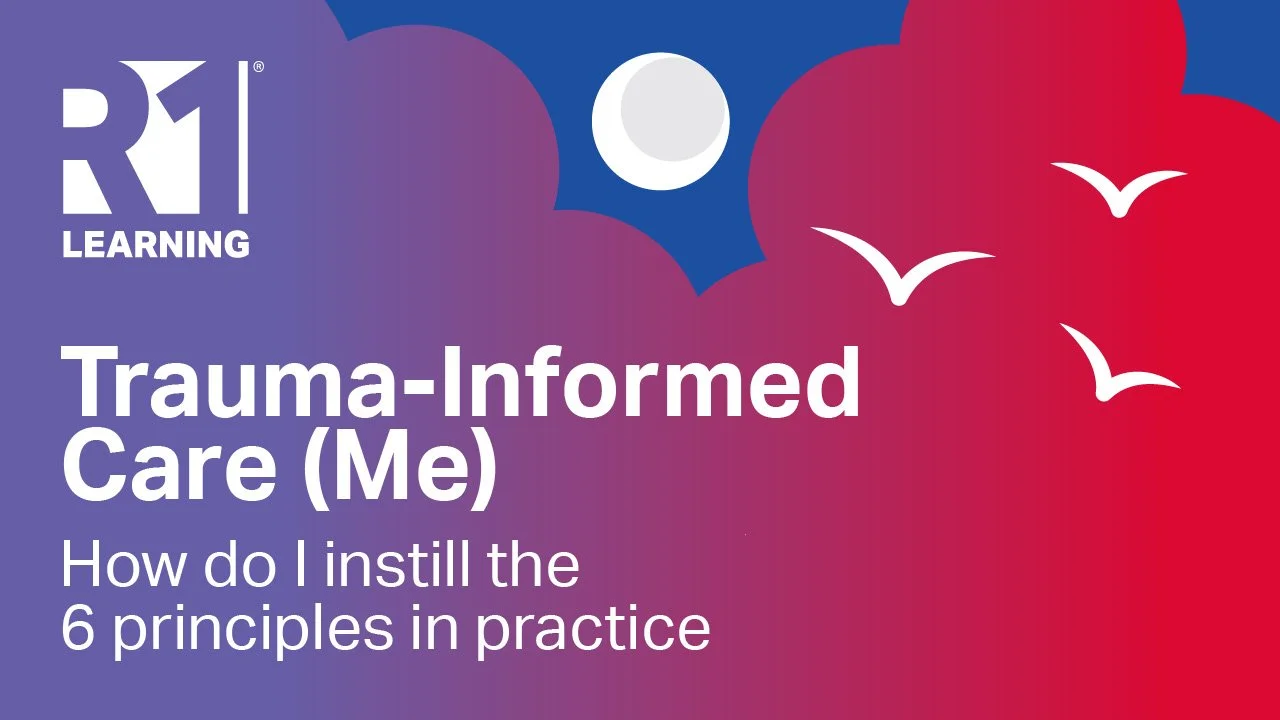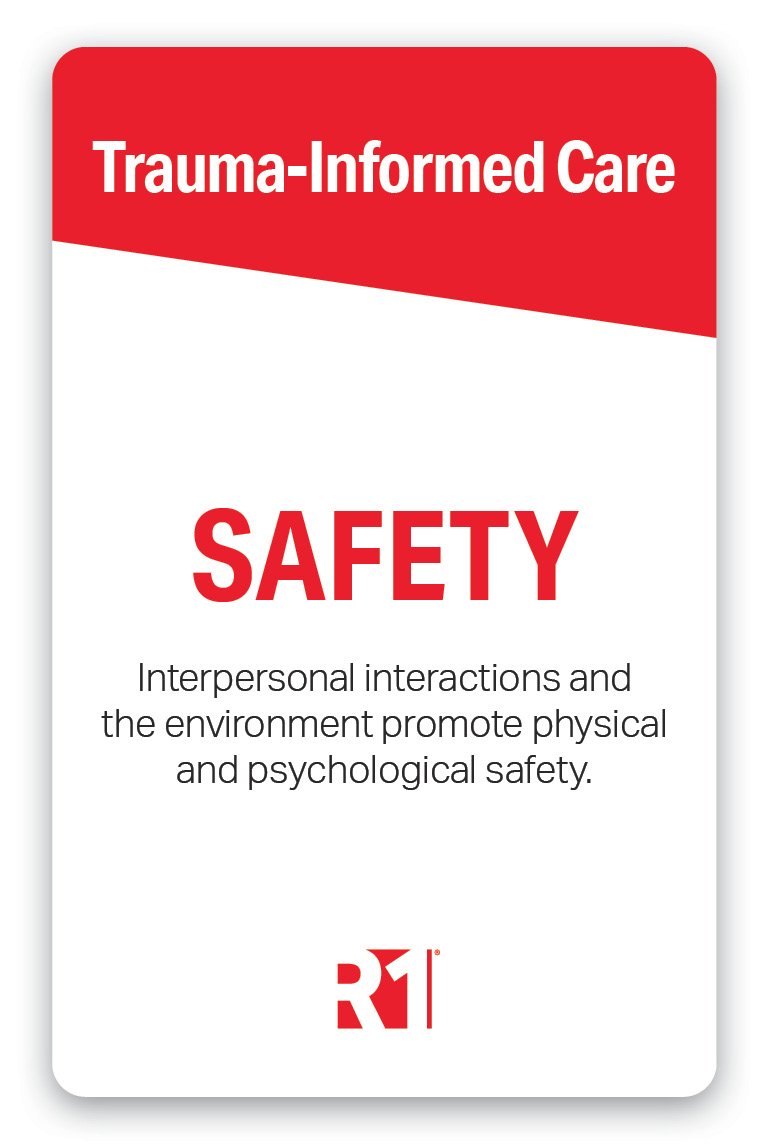Trauma-Informed Care — How Do I Instill the 6 Principles in Practice?
Trauma researchers, practitioners, and survivors recognize that understanding trauma and trauma-specific interventions is not sufficient to optimize outcomes. The context and environment where trauma is treated contributes to the outcomes for the trauma survivor, individuals receiving services, and the individuals staffing the services delivered.
The 6 Guiding Principles of a Trauma-Informed Care approach were developed by the Center for Disease Control's (CDC) Center for Preparedness and Response (CPR), in collaboration with SAMHSA's National Center for Trauma-Informed Care (NCTIC). In 2012, the SAMHSA, Trauma and Justice Strategic Initiative developed three key elements of Trauma-Informed Care:
Realizing the prevalence of trauma.
Recognizing how trauma affects all individuals involved with programs, organizations, or systems, including the workforce.
Responding effectively to trauma by putting this knowledge into practice.
These key elements led to a comprehensive document called Trauma-Informed Care in Behavioral Health Services, TIP 57 (2014). This document has become a worldwide standard for identifying and implementing trauma-informed care in behavioral health and substance use disorder care systems. SAMHSA also published a companion document titled SAMHSA’s Concept of Trauma and Guidance for a Trauma-Informed Approach (2014). This document was developed to provide a research-based explanation of trauma and its impact on substance use and mental disorders.
In a Trauma-Informed Care environment, all staff are trained in Trauma-Informed Care 6 Guiding Principles (at left) and held to the Trauma-Informed Care standards. “All staff” includes the front desk staff, security, clinical and peer staff, and the management team. Trauma-Informed Care organizations share decision-making with staff, individuals being served, community partners, and other concerned individuals, forming a person-centered approach to care. The main goal is to prevent re-traumatization, avoid stigma, empower staff and individuals, and provide inclusive care that includes concerned significant others. These 6 Guiding Principles are expanded and modified to address special populations, considering age, culture, gender, historical trauma, mental health, and substance use issues.
Adopting a Trauma-Informed Care approach is not accomplished through any single technique, training, or checklist. Effective trauma-informed care requires constant awareness, attention, caring, sensitivity, and possibly a cultural change at the organizational level. On-going individual and organizational assessment of the 6 Guiding Principles will help embed this approach into daily practices.
The purpose of today’s post is to share the fundamentals regarding the 6 Guiding Principles of Trauma-Informed Care. We encourage you to test your knowledge and use this post to assess your own settings and practices. Do you know the basics? How do you instill these practices in your work setting daily? How does your organization support you and others? Take a moment to review the definitions and examples for each of the 6 Guiding Principles below. Then read through the Questions to Explore for yourself or with others in your organization. The R1 Trauma-Informed Group Kits and R1 Discover App enable self and organizational assessment to improve your practices. The R1 tools will provide insight into the strengths and gaps of individuals and your organization as a whole. These tools enable you and your team to identify and set SMART goals to ensure a healthy and safe environment for all.
Explore R1 Discover — Interactive Engagement Tools
Trauma-Informed Care, The 6 Principles Defined
The Trauma-Informed Care 6 Guiding Principles are listed below. For each, you will find a brief definition and examples for both the Discovery Cards behavioral statements and Questions to Explore. Note that we have a companion version for organizational supervision that highlights the 6 Guiding Principles from the organization’s perspective (WE). The R1 Facilitator Guide highlights both versions with a side-by-side comparison.
Safety — Ensure physical and psychological safety: Staff and individuals in service, whether children or adults, feel physically and psychologically safe; the physical setting is safe and interpersonal interactions promote a sense of safety.
2 of 5 Discovery Cards Examples:
I feel physically and psychologically safe at work
I have been trained on how to recognize trauma symptoms and use universal precautions
2 of 5 Questions To Explore Examples:
How do you respond when an individual states they do not feel safe?
What does re-traumatization mean to you? How do you recognize it?
Trust — Build trust through transparency: Organizational operations and decisions are conducted with transparency with the goal of building and maintaining trust.
2 of 5 Discovery Cards Examples:
I am transparent with individuals, families, and co-workers
I communicate clear and realistic expectations with individuals and families
2 of 5 Questions To Explore Examples:
How do you ensure that individuals understand and are in agreement with trauma-informed care expectations?
How are you encouraged to admit when you make a mistake without fear of retaliation?
Peer Support — Value peers as an integral part of care services: Peer support and mutual self-help are key vehicles for establishing safety and hope, building trust, enhancing collaboration, and utilizing their stories and lived experience to promote recovery and healing.
2 of 5 Discovery Cards Examples:
[For peers] I use my story and lived experience appropriately for the benefit of the individuals I serve
[For peers] I establish safety, hope, and trust with the individuals I support
2 of 5 Questions To Explore Examples:
How do you know when to share relevant parts of your story?
How do you greet individuals in a warm and welcoming manner? What do you say or do?
Collaboration — Collaborate through respectful shared decision making: Importance is placed on partnering and the leveling of power differences between staff and individuals and among all organizational staff demonstrating that healing happens in relationships and in the meaningful sharing of power and decision making.
2 of 5 Discovery Cards Examples:
I am supported by my organization to make decisions and take action
I acknowledge the individual as the expert in their own life
2 of 5 Questions To Explore Examples:
How does the organization support you to make decisions and take action timely? Do you feel trusted to make decisions on your own in the moment?
What strategies do you use to build informal and formal relationships with individuals?
Empowerment — Empower others through their strengths, voice, and choices: The organization recognizes and builds upon the strengths and experiences of individuals, believes in the resilience and ability for individuals to recover from trauma, and supports staff and individuals through a shared decision-making, choice, and goal setting process.
2 of 5 Discovery Cards Examples:
I empower individuals to make their own choices and decisions
I recognize that individuals make choices based on their own values
2 of 5 Questions To Explore Examples:
How do you empower individuals to make their own choices? What do you do when an individual makes a decision that you disagree with?
How do you communicate in a way that ensures transparency and understanding?
Culture — Recognize and respect all cultures and historical trauma: The organization actively offers access to gender responsive services; leverages the healing value of traditional cultural connections; and incorporates policies, protocols, and processes that are responsive to the racial, ethnic, gender, and cultural needs of the individuals served; and recognizes and addresses historical trauma.
2 of 5 Discovery Cards Examples:
I acknowledge and respond to racial, ethnic, cultural, and gender needs
I am respectful and flexible in meeting the cultural needs of individuals
2 of 5 Questions To Explore Examples:
What are some ways that you have made modifications to standard policies based on individual needs?
How do you communicate to staff when a modification is needed?
3 Environment Types – How Do I Ensure My Environment Supports the Practice of Trauma-Informed Care?
The environment in which the Trauma-Informed Care 6 Guiding Principles are practiced requires individual and organizational observation, evaluation, and ongoing action. Knowing the categories and best practices to look for help to guide behavior toward improving safety, trust, collaboration, empowerment, and the culture as a whole.
Physical: The physical spaces, surroundings, and conditions in which we work
2 of 5 Discovery Cards Examples:
Our environment is clean and uncluttered
Our environment is well lit and clear of safety hazards
2 of 5 Questions To Explore Examples:
How clear is our signage for new individuals coming to our program? What can we do to improve it?
Which physical areas have noise levels that are too loud or distracting? What can we do to make it more quiet and calm?
Psychological: The mental and emotional atmosphere in which we work
2 of 5 Discovery Cards Examples:
Our environment is warm and welcoming
Our environment provides a safe, calm, and secure setting
2 of 5 Questions To Explore Examples:
What do we do to keep our environment clean and clutter-free? Which spaces can we improve? How?
What in our environment promotes safety and calmness? Explain.
Social: The people interactions in the settings in which we work
2 of 5 Discovery Cards Examples:
Our environment provides welcoming and safe social spaces for individuals, families, and staff
Our environment includes common areas for individuals to gather and socialize
2 of 5 Questions To Explore Examples:
Which areas provide the most privacy for individuals, families, and staff? How do individuals find and use these spaces?
Where do staff meet with individuals or families in private? What public or more open areas are available if needed?
What’s In the Deck — 2 Versions (ME and WE)
Questions to Explore
Answer the following questions for yourself or with your team:
Do you find the Trauma-Informed Care Model helpful in thinking about how to effectively practice in settings where trauma is present?
Which of the 6 Guiding Principles are your strengths? Explain.
Which of the 6 Guiding Principles do you see opportunity for improvement and growth for yourself? Explain.
How does your knowledge of the 6 Guiding Principles help you to better instill these principles in your day-to-day practice?
How can you and your team use this information to assess and address gaps in your environment?
What will be the benefit for you and others as you practice these principles more fully overtime?
What is your major learning or takeaway from the post? Explain.
Thank you for reading this post and participating in this activity. Contact us if you would like to learn more about our Trauma-Informed Care solutions and the R1 Learning System. We look forward to hearing from you.
The 6 Guiding Principles for a trauma-informed approach were developed by the Center for Disease Control's (CDC) Center for Preparedness and Response (CPR), in collaboration with SAMHSA's National Center for Trauma-Informed Care (NCTIC).
References
Substance Abuse and Mental Health Services Administration. Trauma-Informed Care in Behavioral Health Services. Treatment Improvement Protocol (TIP) Series 57. HHS Publication No. (SMA) 13-4801. Rockville, MD: Substance Abuse and Mental Health Services Administration, 2014.
Center for Health Care Strategies. (2021). Trauma-Informed Care Implementation Resource Center. https://www.traumainformedcare.chcs.org/
Substance Abuse and Mental Health Services Administration: Practical Guide for Implementing a Trauma-Informed Approach.
SAMHSA Publication No. PEP23-06-05-005. Rockville, MD: National Mental Health and Substance Use Policy Laboratory. Substance Abuse and Mental Health Services Administration, 2023.
Office for Health Improvement and Disparities. (2022). Guidance: Working definition of trauma-informed practice. GOV.UK. https://www.gov.uk/government/publications/working-definition-of-trauma-informed-practice/working-definition-of-trauma-informed-practice
Copyright 2024 R1 Publishing LLC / All Rights Reserved. Use of this article for any purpose is prohibited without permission.
A Special “Thank You” from R1!
Again, a special “thank you” and “hat’s off” to Sandy Rivers with Authentic Trainings LLC for her collaboration with R1 in the development of both our Adverse Childhood Experiences (ACEs) and Trauma-Informed Care topics. Her knowledge, skills, experience, and passion for these topics have been invaluable to R1’s mission. We are grateful that she shares her talents with R1!
Organizational Development. Engage, Train, and Retain Your Team.
Trauma-Informed Discovery Cards and Group Kits
The R1 tools below provide insight and goal setting opportunities for both our 1) Practitioners & Staff (ME) and 2) Organizational Supervision (WE) versions. Although we’ve highlighted the ME versions of the models on many of the reference pages, you’ll find the details for both the ME and WE versions together so you can see the relationships between the two. Use both versions in unison to create a culture that instills the Trauma-Informed Care 6 Guiding Principles.Integrating these tools into your groups will allow individuals to build their own vocabulary, think about these concepts concretely, and put their choices into action. Visit the R1 Store to learn more about a variety of topics. The Discovery Cards are an amazing tool for exploring these topics with individuals or groups.
Here are a few ideas to help you learn more about R1 and engage others on this topic:
Share this blog post with others. (Thank you!)
Start a conversation with your team. Bring this information to your next team meeting or share it with your supervisor. Change starts in conversations. Good luck! Let us know how it goes.
Visit www.R1LEARNING.com to learn more about R1, the Discovery Cards, and how we’re creating engaging learning experiences through self-discovery.


























